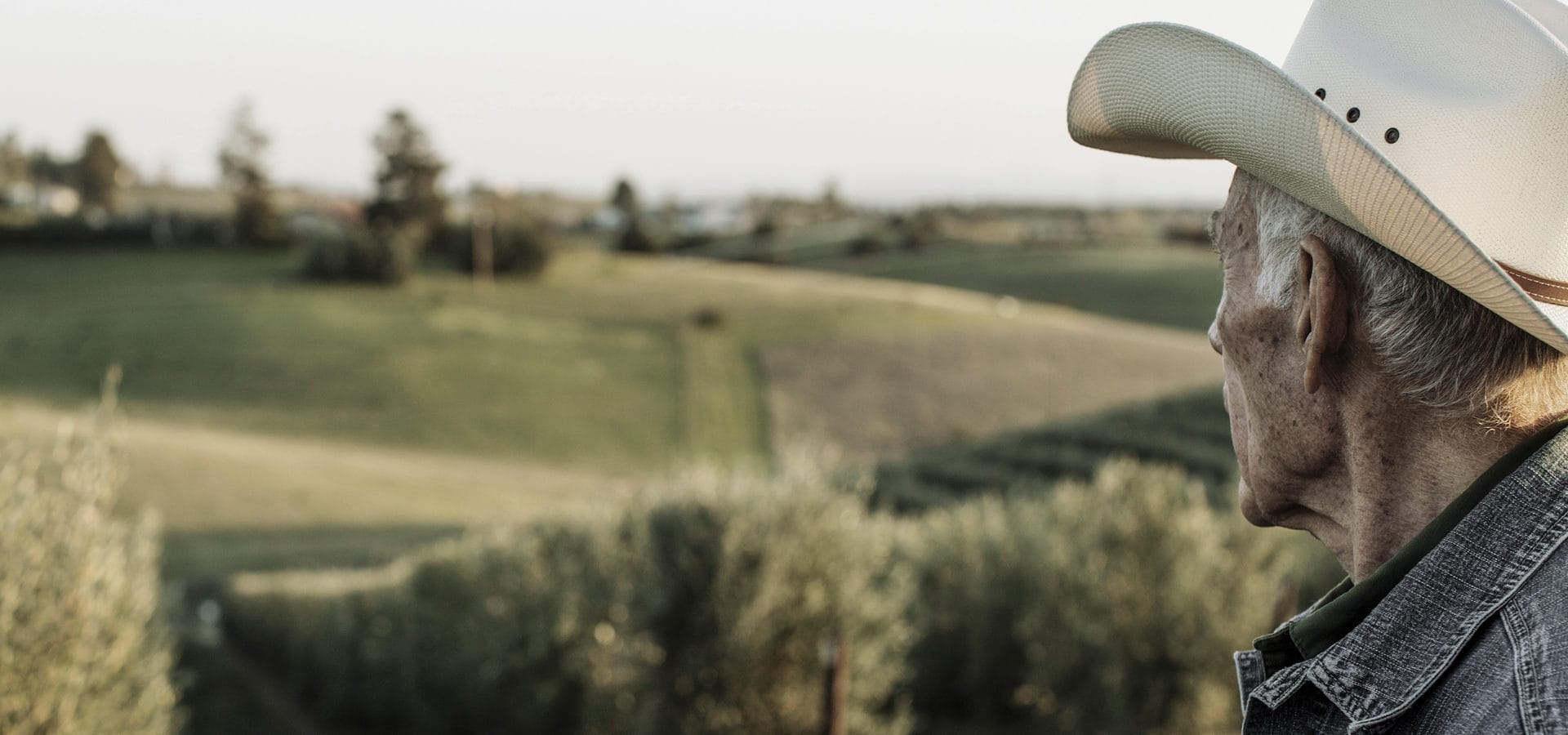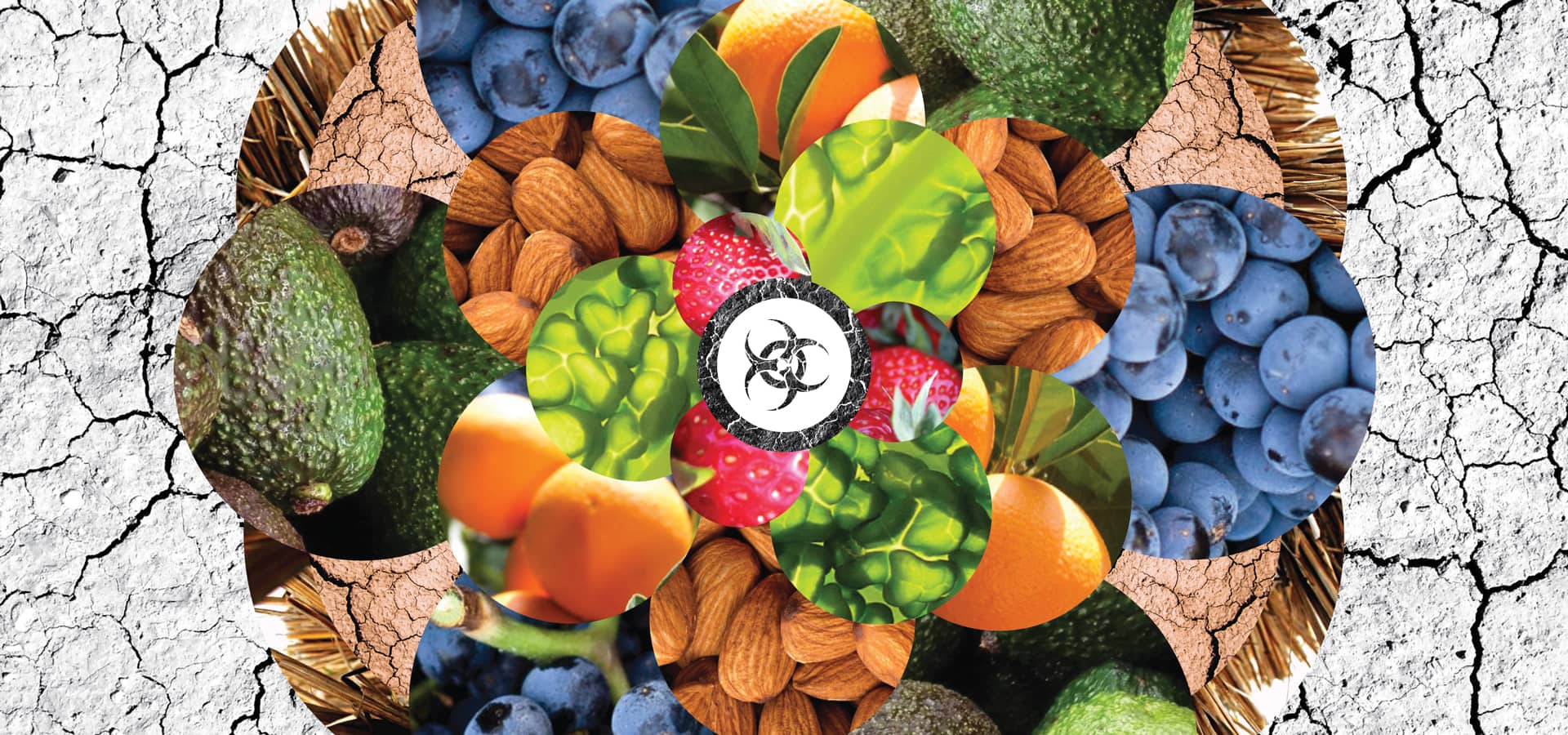A Movement to Correct Decades of Farming Damage Is Germinating at the Grassroots Level in California
Soil and trouble.
-
CategoryFarm + Table, Sustainability
-
Written byBonnie Graves
-
Illustrated byYasmine Kahsai
$2.055 billion. It’s a staggering figure—more than the gross domestic product reported of 26 different countries. Yet that’s the amount a jury in Oakland awarded plaintiffs Alva and Alberta Pilliod on May 13 for both compensatory and punitive damages.
The defendant? Monsanto (now owned by German conglomerate Bayer) and its glyphosate-ridden Roundup weed killer. Like the plaintiffs in two previous lawsuits filed against Bayer-Monsanto, the Pilliods contend that their non-Hodgkin’s lymphoma was caused by a lifetime of exposure to Roundup. American juries have agreed, although predictably Bayer-Monsanto has appealed and delayed the award of any monies such that some of these plaintiffs may well die of cancer before they see any compensation.
A quick Google search is revealing. Sponsored ads from lawyers soliciting clients with cancer cases connected to Roundup are jarringly intermixed with ads from Target, Amazon and Walmart—all cheerfully competing to ship the herbicide to you at discount rates. As demonstrated by the inexorable battle against big tobacco, regulatory wheels don’t get greasy until the squeak gets loud enough.
Much like the anti-vaccine movement, the controversy surrounding glyphosate and its carcinogenic effects can be traced to an alarming intermingling of actual science and pseudoscience. The former requires established principles of open and transparent procedures and peer review—something that was notably lacking in a seminal report submitted to the European Union (EU) in 2014 by the German Federal Institute for Risk Assessment, in which glyphosate was determined to be “harmless,” at least in small doses.
“A nation that destroys its soils destroys itself.” —Franklin D. Roosevelt
Here in America, the use of glyphosate is even less regulated. Just last May the Environmental Protection Agency (EPA) reaffirmed its stance, based on research conducted back in 1993, that glyphosate is not a carcinogenic compound. Tellingly, CNN later discovered and released internal emails sent between a Monsanto executive and a key EPA regulator in which they appear to collude in a plan to quash an updated inquiry into the herbicide’s harmful effects.
From 1974 to 2014 the use of glyphosate in American agriculture increased by 300% in correlation with the rise of Monsanto’s sister product, Roundup Ready crop seeds, which are genetically modified in order to flourish in tandem with the herbicide. It’s akin to marketing opioids and naloxone simultaneously, i.e., create the dependent market and then sell its alleviation.
It’s certainly smart business, even if it’s morally reprehensible. It is as difficult to overstate the degree to which our American soils are now saturated with this chemical as it is to overstate the dependency of most farmers. Many farmers can no longer realistically afford the financial risk of growing without chemicals.
Simply put, our soils are sick. Our soils are chronically unhealthy, and that’s before we consider the health of the animals that graze on them or the equally catastrophic impact of the antibiotics that these ruminants are force-fed.

The Biggest Little Farm
Moorpark farmers Molly and John Chester
YOU ARE WHAT YOU EAT
Soil health ultimately dictates human health, and the old adage “you are what you eat” is both terrifying and inspiring in an era of chemical saturation. The good news is that we live in California, where we are leading the rest of the country in tackling soil pollution—among other environmental initiatives.
On May 8 Governor Gavin Newsom officially banned the use of chlorpyrifos, a pesticide linked to childhood brain damage. Just two years ago former EPA head Scott Pruitt mounted a last-minute campaign to override his own agency’s recommendation that this pesticide be banned nationally.
In August the U.S. Court of Appeals for the Ninth Circuit ruled that Pruitt’s decision was a direct violation of federal law and ordered the EPA to ban chlorpyrifos nationwide within 60 days. Current EPA head Andrew Wheeler has defied the court’s order, and the matter is now set to be resolved by President Trump’s Justice Department in July—with grim implications for American children not lucky enough to consume produce grown in a chlorpyrifos-free California.
And while Roundup is not yet illegal statewide, many local municipalities have banned it regardless—including all of Los Angeles County, where it can no longer be used for weed eradication along public thoroughfares. Californians apparently won’t wait for the federal government to tell us what’s healthy or not, and that’s a very good thing.
Any solution to a large-scale public health risk begins at the grassroots level, and in this case it’s doubly appropriate. Soil advocacy begins on the ground level, and while we should take pride in our local and state legislative initiatives, we also need to take independent action as citizen activists.
What is clearly emerging is a movement—a movement that encompasses farmers, doctors, chefs and advocates from all walks of life. Unifying them is a foundational belief that “food is medicine.” What we eat—and how it is grown—is fundamentally linked to our physical well-being in a much more complex way than has previously been understood.
As the renowned Indian scholar and Gandhian activist Vandana Shiva puts it, “Regenerative agriculture provides answers to the soil crisis, the food crisis, the health crisis, the climate crisis and the crisis of democracy.” As the founder of the Research Foundation for Science, Technology and Natural Resource Policy (RFSTN)—an organization devoted to developing sustainable methods of agriculture—Dr. Shiva’s early research and activism has inspired a generation, both here in California and around the globe. It was she who first connected the dots between monoculture, synthetic-dependent farming and corollary climate and health crises.
Increasingly, epidemiologists and other public health experts are also turning to the soil—literally and figuratively. Among several prominent American doctors, the work of Zach Bush, MD, is consistently cited by soil advocates. Dr. Bush is triple board-certified in internal medicine, endocrinology metabolism and hospice/palliative care. In practice this means he has deep clinical experience and a rare linear observation of how our digestive tract and organ systems integrate with our metabolic baseline over the course of a lifetime, including palliative care for life-ending diseases.
Typically, doctors specialize more deeply, which can create crippling myopia as surely as it creates siloed expertise. This guy’s vision is much more expansive. Dr. Bush’s mission statement is to “provide a foundation of cutting-edge philosophy and science for a grassroots movement that will change our business and legislative structures and ultimately upshift consumer behavior to bring about radical change in the mega industries of big farming, big pharma and Western medicine at large.”
In tech parlance this is called “disruption,” and if you’re doubtful that it can be done in the food business, take a look at the relationship between Tesla and the automotive industry, or at Airbnb and its impact on hotels. Disenchanted with traditional Western medicine and its reliance on pharmaceuticals, Dr. Bush left his medical practice 10 years ago in order to advocate for a new understanding of wellness. His goal is to teach that a healthy environment leads to a healthy gut, which in turn leads to overall physical and mental well-being.
Of Dr. Bush’s many endeavors, the Farmer’s Footprint initiative seems most compelling (farmersfootprint.us). It’s an ambitious, Instagram- and media-friendly campaign that supports farmers converting to regenerative farming practices, with a goal of reclaiming 5 million acres of farmland by 2025. A documentary film of the same name spotlighting one Minnesota family farm’s successful transition to regenerative techniques was released in February, and it’s well worth the watch.
Again the link between sick soils and sick Americans is made explicit. Dr. Bush asserts, “A century of monocrop farming and reliance on pesticides has damaged our nation’s once-fertile soils and the health of every American. The rapid increase in pesticide use over the past few decades has coincided with this explosion of chronic disease.”
He continues to note, “A profound change in the demographics of chronic disease is underway in the United States. Independent research from private laboratories and universities around the world are implicating glyphosate—the active ingredient in the herbicide Roundup.”
Dr. Bush, like other medical professionals, is increasingly alarmed that the same companies that manufacture medicines may also be manufacturing the chemicals that cause disease, e.g., Bayer’s acquisition of Monsanto as an exemplary case.

HOME TURF
Regenerative agriculture is on the rise in the Golden State. In practice this involves not just the eschewing of pesticides and synthetic fertilizers. It’s as much about the do’s as the don’ts when restoring soil to a more natural, nutrient-dense state. Keeping the soil intact (no tilling), using diverse cover crops and planning multiple crop rotations all help create carbon-rich soil rife with the vital microbes that in turn lead to healthy microbes in the human gut.
In Moorpark, for example, we find Apricot Lane Farms, featured recently in the wide-release film The Biggest Little Farm. Founded by husband-and-wife team Molly and John Chester, Apricot Lane is an incubator for soil health and is a lab of sorts for teaching regenerative practices.
When asked at a recent conference in Los Angeles about the long-term prospects of Apricot Lane Farms, Molly admitted that it often comes down to outside funding. While regenerative farming has quantifiable benefits, it is definitely not yet profitable. You can only recoup so much expense at a farmers market, selling DTC (direct-to-consumer) to people who care. When up against Big Ag, as The Biggest Little Farm documentary points out, it really is a case of David versus Goliath.
The solution for farmers interested in healthier practices is to broaden their markets, and one important way to do that is to work directly with restaurants. Because the food industry is so heavily regulated, it is challenging for chefs to purchase directly from farmers. Ironically, our many health and sanitation regulations prohibit farmers from simply showing up at the restaurant door with a truckload of healthy produce.
The Santa Monica Farmers Market, however, is a model that successfully connects farmers and chefs. Launched in 1981, the Wednesday market features more than 75 vendors, many of whom grow sustainably or organically. A trend that now seems commonplace among top restaurants is to acknowledge food origins in restaurant menus, e.g., not just berries but “Harry’s Berries.”
Chefs often cite vendors by name or location, which in turn strengthens the connection between farm and table. People increasingly want to know where their food is grown, and they want to know if it is grown with or without the use of chemicals.
While the farmers market model works in a year-round growing season like California’s, it is more challenging to replicate in other climates. Restaurateurs, like father-and-son duo Matthew and Ryland Engelhart, are examples of food entrepreneurs who are finding creative ways to work directly with farmers. At age 48, Matthew left his career in apparel to found Café Gratitude, a “transformational business in the form of a restaurant.”
With multiple locations across California, the brand has expanded to include Gracias Madre and the upscale Gratitude restaurant as well. Conceptually, this restaurant group serves primarily plant-based cuisines, although environmentally friendly meats were introduced several years ago.
“Regenerative agriculture provides answers to the soil crisis, the food crisis, the health crisis, the climate crisis and the crisis of democracy.”
At Gracias Madre, an homage to Mexican mothers and their indigenous cuisines, Chef Chandra Gilbert’s masa is made exclusively from organically grown corn that is also directly sourced. Ryland notes, “We promote regenerative agriculture. All the corn used in our restaurants to make tortillas and tamales comes from a regenerative farm in Nebraska that practices crop rotation. We use the restaurants to show that the most important conversation is about food that is healthy, not only for our bodies but also for regenerating landscapes.”
Ryland is also the cofounder of Kiss the Ground, a 501(c)(3) nonprofit dedicated to regenerative farming and soil restoration. Launched just over five years ago, Kiss the Ground is an innovative advocacy group whose main client just happens to be Mother Earth.
Matthew has also pointed out the connection between low-cost, chemically dependent food production and chronic illness. He uses the expression, “Our food is cheap, and we are sick.”
“In the 1960s Americans spent an average of 18% of their household budget on food and 8% on health care,” Matthew says. “Today this relationship has changed. Chronic diseases, such as diabetes and heart problems, are more common and kill more people than ever in history.”
Spending more on food as preventative medicine—and less on pharmaceuticals—is the paradigm shift many are seeking to enact. Cue the Lunch Lady. Eating farm-to-table takes on a different context entirely when the table is at a school.
Hilary Boynton may lack the hairnet and the Styrofoam tray, but this lunch lady is on a mission to alleviate childhood illness by improving school lunch offerings. A mother of five who once struggled with infertility issues, Hilary is an evangelist for intestinal health and its potential to offset illness.
She wrote The Heal Your Gut Cookbook with fellow nutrition expert Mary Bracket, featuring nutrient-dense recipes designed to minimize the inflammation that Dr. Bush and other medical experts causally link to a host of diseases. Incidentally, the recipes are also delicious and family-friendly. The inspiration for the book came from her own children’s health needs; from eczema to asthma to epilepsy, Hilary repeatedly found that what she fed her kids was as impactful as traditional medicines.
“Food is medicine,” she told me as she flashed a blood glucose monitoring patch she was wearing as part of a citizen-science school project. She likes to use the metaphor of a fish tank. “You can feed the fish organic foods or give them drugs, but if you don’t clean the tank they’ll never get better.”
Like Dr. Bush, Hilary’s approach to food centers on protecting healthy microbes in the gut. Her day job is at the Manzanita School in Topanga Canyon, where she prepares snacks and lunches that are light-years ahead of industrial chicken nuggets and microwaved pizza.

SEEDS OF ADVOCACY
Access to healthy food is, of course, a socioeconomic issue. The privilege of choosing organically grown foods that cost more is just that—a privilege. Advocates for the disadvantaged are also seeking to implement healthier foods and to disrupt the cycle of chronic illness.
Chefs Daniel Patterson and Roy Choi made headlines several years ago with their healthy fast-food concept, LocoL. While the intentions were noble and the design and menu were appealing, the Watts location failed quickly even though it was located in a food desert with few to no restaurant choices and a median income of just $25,000. The Oakland and San Jose LocoL franchises were shuttered as well.
If you build it, they still may not come. This is apparently the lesson here. Change can be painfully slow.
A different strategy was employed successfully by CALPIRG, whose lobbying efforts recently resulted in a commitment from McDonald’s—the country’s single biggest purchaser of beef—to reduce antibiotics in its meat supplies. It’s a huge step forward toward safeguarding the health of everyone in the U.S. Everyone needs antibiotics to remain effective when needed for critical medical treatment; whether they eat at McDonald’s or not is a secondary issue.
Another unsung hero preaching the healing powers of soil is Carolyn Day, a former stuntwoman and professional surfer who recently started a nonprofit called Growing Hope Gardens. She is a master gardener who works with homeless shelters and transitional housing developments to install and maintain organic garden beds. While the gardens may not provide all the food the shelters’ residents require, the connection to the soil and the experience of growing food is often a first for many folks.
Carolyn explains, “We believe that time spent in contact with nature through these gardens will provide meaningful, rewarding work and a safe environment for healing. While growing nutritious organic produce, our garden programs will create a sense of belonging and the opportunity to make beneficial human connections.”
Growing Hope Gardens aligns with many fellow organizations in its regenerative, chemical-free techniques that also reduce the carbon imprint of the shelters they serve. Carolyn feels passionately that the homeless and “people of small means” also deserve access to healthier foods.
The impact of sick, glyphosate-saturated soils planted with GMO crops should be considered a public health crisis akin to tobacco use, lead in household paints, the lack of seat belt use, drunk driving and other life-threatening risks. The situation is that dire.
Dr. Bush asserts, “As the health of the soils and the plants that grow in them has diminished, chronic disease has gone epidemic. In the 1960s the entire U.S. population had a chronic disease burden of 4%. Today 46% of our children carry a chronic disease diagnosis. We have never imagined, let alone witnessed, this level of chronic disease.”
The good news is that we can do something about this, and we must do something about this for the well-being of our children and of our planet. From the food choices we make in our own homes to pressuring our elected officials to supporting advocacy work, each of us can be a part of the regenerative work needed to restore healthy soils and cleanse our food supply of disease-causing chemicals. And the time to start was yesterday, so let’s squeak loudly and get the wheels of change moving.
This Architect Gave LAX Its Futuristic Theme Building
Jet set meets Jestsons.
A Smaller Footprint for a Larger Impact
From the food they eat to where they live, Trevor and Maddie Gordon are choosing to do more with less.
Get the Latest Stories






